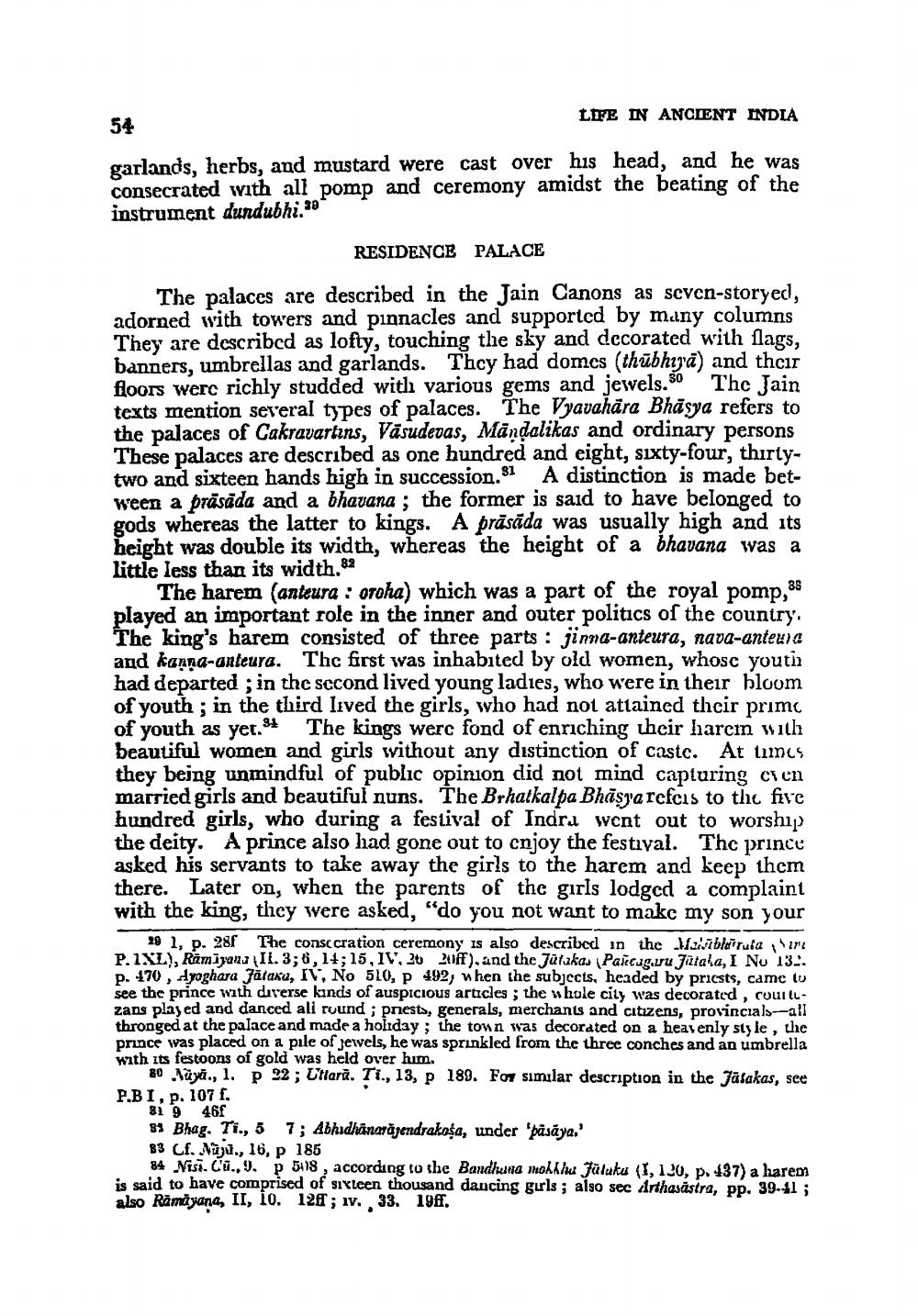________________
LIFE IN ANCIENT INDIA
54
garlands, herbs, and mustard were cast over his head, and he was consecrated with all pomp and ceremony amidst the beating of the instrument dundubhi.
RESIDENCE PALACE
The palaces are described in the Jain Canons as seven-storyed, adorned with towers and pinnacles and supported by many columns They are described as lofty, touching the sky and decorated with flags, banners, umbrellas and garlands. They had domes (thubhra) and their floors were richly studded with various gems and jewels.30 The Jain texts mention several types of palaces. The Vyavahara Bhasya refers to the palaces of Cakravartins, Vasudevas, Mandalikas and ordinary persons These palaces are described as one hundred and eight, sixty-four, thirtytwo and sixteen hands high in succession.81 A distinction is made between a präsäda and a bhavana; the former is said to have belonged to gods whereas the latter to kings. A prasada was usually high and its height was double its width, whereas the height of a bhavana was a little less than its width.82
35
31
The harem (anteura: oroha) which was a part of the royal pomp,3 played an important role in the inner and outer politics of the country. The king's harem consisted of three parts: jinna-anteura, nava-anteura and kanna-anteura. The first was inhabited by old women, whose youth had departed; in the second lived young ladies, who were in their bloom of youth; in the third lived the girls, who had not attained their primc of youth as yet. The kings were fond of enriching their harem with beautiful women and girls without any distinction of caste. At times they being unmindful of public opinion did not mind capturing even married girls and beautiful nuns. The Brhatkalpa Bhasya refcis to the five hundred girls, who during a festival of Indra went out to worship the deity. A prince also had gone out to enjoy the festival. The prince asked his servants to take away the girls to the harem and keep them there. Later on, when the parents of the girls lodged a complaint with the king, they were asked, "do you not want to make my son your
28 1, p. 28f The consecration ceremony is also described in the Mableruta Sine P. 1XL), Ramayana II. 3;6, 14; 15, IV, 20 20ff), and the Jutakas Palcagaru Jataka, I No 13. p. 170, Ayoghara Jataka, IV, No 510, p 492, when the subjects, headed by priests, came to see the prince with diverse kinds of auspicious articles; the whole city was decorated, courtuzans played and danced all round; priests, generals, merchants and citizens, provincials-all thronged at the palace and made a holiday; the town was decorated on a heavenly style, the prince was placed on a pile of jewels, he was sprinkled from the three conches and an umbrella with its festoons of gold was held over him.
80 Naya., 1. p 22; Uttara. Ti., 13, p 189. For similar description in the Jalakas, see P.BI, p. 107 f.
81 9 46f
81 Bhag. Ti., 5 7; Abhidhanarajendrakosa, under 'pāsāya,'
83 Cf. A., 16, p 185
84 Nisi. Cu., 9. p 508, according to the Bandhuna mokkha Jaluku (1, 120, p. 437) a harem is said to have comprised of sixteen thousand dancing girls; also sec Arthasästra, pp. 39-11; also Ramayana, II, 10. 12f; iv., 33. 19ff.




